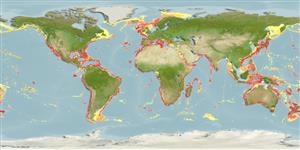Actinopterygii (ray-finned fishes) >
Beryciformes (Sawbellies) >
Trachichthyidae (Slimeheads)
Etymology: Hoplostethus: Greek, hoplon = weapon + Greek, stetho, stethion = brest; literal = to prick a little breast (Ref. 45335).
Environment / Climate / Range
Ecology
Marine; benthopelagic; depth range 100 - 1175 m (Ref. 9942). Subtropical, preferred 23°C (Ref. 107945); 68°N - 78°S, 98°W - 167°W
Cosmopolitan. Eastern Atlantic: Ireland to Senegal, Canary Islands, and the Gulf of Guinea, including the Mediterranean; also Namibia and South Africa (Ref. 4181). Reported from Iceland (Ref. 12462). Western Indian Ocean: Red Sea (Ref. 9942) and South Africa (Ref. 4181). Western Atlantic: Georges Bank to northern Gulf of Mexico, Great Antilles, and Venezuela to southern Brazil (Moore, pers. comm.).
Length at first maturity / Size / Weight / Age
Maturity: Lm 16.5, range 13 - ? cm
Max length : 42.0 cm SL male/unsexed; (Ref. 3397); common length : 20.0 cm SL male/unsexed; (Ref. 4784); max. reported age: 11 years (Ref. 26316)
This species is reported to be pelagic in Maul, 1990 (Ref. 3583); however, Schneider, 1990 (Ref. 2683) indicates the species is demersal. Found over muddy bottom (Ref. 26999).
Life cycle and mating behavior
Maturity | Reproduction | Spawning | Eggs | Fecundity | Larvae
Maul, G.E., 1990. Trachichthyidae. p. 620-622. In J.C. Quéro, J.C. Hureau, C. Karrer, A. Post and L. Saldanha (eds.) Check-list of the fishes of the eastern tropical Atlantic (CLOFETA). JNICT, Lisbon; SEI, Paris; and UNESCO, Paris. Vol. 2. (Ref. 3583)
IUCN Red List Status (Ref. 115185)
CITES (Ref. 94142)
Not Evaluated
Threat to humans
Harmless
Human uses
Fisheries: of no interest
Tools
Special reports
Download XML
Internet sources
